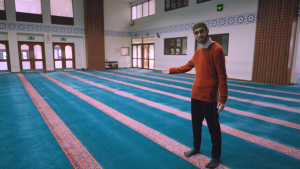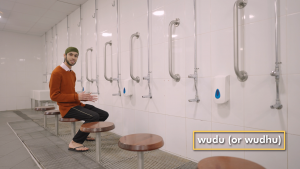Watch Azeen practise and describe a rak’ah – the positions that Muslims perform during prayer.
Curriculum Mapping
Component 1: The study of religions: beliefs, teaching and practices – Beliefs and teachings - Islam - Salah and its significance: how and why Muslims pray including times, directions, ablution (wudu), movements (rak’ahs) and recitations; salah in the home and mosque and elsewhere; Friday prayer: Jummah; key differences in the practice of salah in Sunni and Shi’a Islam, and different Muslim views about the importance of prayer.
Area of Study 3 – Islam Section 1: Muslim Beliefs - Salah as one of the Five Pillars, including reference to Surah 15: 98–99 and 29: 45: the nature, history, significance and purpose of Salah for Sunni and Shi’a Muslims, including different ways of understanding them; how Salah is performed including ablution, times, directions, movements and recitations, in the home and mosque and Jummah prayer."
Component Group 1–Practices - Islam - Public acts of worship - Salah as direct communication with Allah - Component Group 1–Practices - Islam - Public acts of worship - Salah as direct communication with Allah. The importance of practices - Islam as a way of life, lived in total submission to Allah • The importance of the Five Pillars of Islam to Sunni Muslims • The meaning of the Five Pillars: •• Shahadah: sincerely reciting the Muslim profession of faith •• Salat: performing ritual prayers in the proper way five times each day •• Zakat/Zakah: paying an alms (or charity) tax to benefit the poor and the needy •• Sawm: fasting during the month of Ramadan •• Hajj: pilgrimage to Mecca • The analogy of the house and pillars
2.1 Unit 1 PART A - Part A Islam - Core beliefs, teachings and practices - Practices - The Five Pillars of Sunni Islam -Prayer/ Salat Adhan call to prayer, praying at mosque and Friday Jummah prayer (Qur'an 15:9899, 29:45) Praying at home, private prayer (Du'ah) The preparations and intention for prayer: wudu and niyyah The significance and symbolism of the different prayer positions that make a rakat (sequence of prayer) Obligatory Acts Shahadah: the Muslim profession of faith in Allah and the prophet Muhammad; occasions when the Shahadah is recited, e.g. aqiqah ceremony, conversion to Islam Zakat: paying an alms (or charity) tax to benefit others, what zakat tax may be used for, and additional charity (saddaqah) Sawm: Fasting during the month of Ramadan. How and why Muslims fast during Ramadan and rules about halal and haram diet (Qur'an 2:183)
2.3 Component 3 (Route A) - Option 3: Islam - The Five Pillars of Sunni Islam: practices in Britain and elsewhere - Salah: the practices of prayer in Islam in the mosque and at home, including Jummah prayer: Qur'an 15:98-99, Qur'an 29:45
Transcript
Holy Cribs – Prayer Positions
Azeen: Salah the duty to pray five times a day. We could do it anywhere as long as we've done a wudu and the place we're in is clean and we've got the space to do the movements I'm about to show you. In the prayer hall of a mosque. The carpet is often marked with rectangles for people to stand in or lines across a floor, so everyone has enough space to pray and do the movements without bumping into the people around them. At home I just use a prayer mat. When we pray, we must face the direction of the Ka'bah, which is a cube shaped holy building in the center Makkah in Saudi Arabia. This direction is called the qibla and in a mosque you could tell the qibla by facing the mihrab, which is an archway in the wall at the front of the prayer hall. We pray five times a day. And as well as saying the words in Arabic, we also show our devotion to Allah. First, I should have the intention to pray, which is called the niyyah. So I focus and get myself into the right frame of mind. Then I say Bismillah and the prayer begins. I raised my hands and then lowered them while I say Allahu Akbar. This is called takbir. I'll stand and this is called qiyam. Then I bow from the waist. This is called ruku. Then comes sujud or sajdah, when I kneel down and put my forehead on the floor. This is called prostration in English. I return to the kneeling position called jalsa. Then I prostrate again. And finish in the kneeling position. And that series of movements is called a raka'ah. I'll stand and do more rak'ah's and the number depends on which prayer I'm saying. Each of the positions goes a bit further in showing total submission to Allah. When the prayer is finished and I'm kneeling at the end of the final rak'ah I turn to my right and then my left to say, salam. Peace be with you. After the prayer in Arabic. I can also say my personal prayers in English. And this is called du'a.








